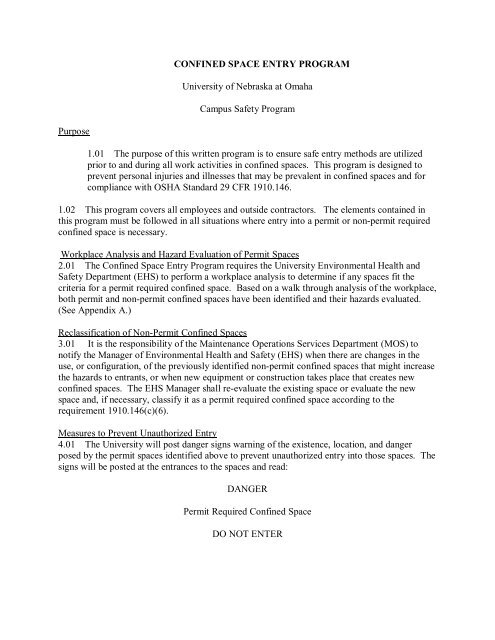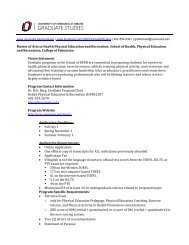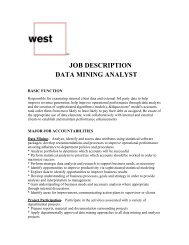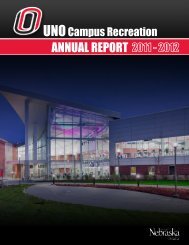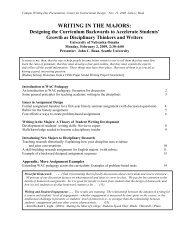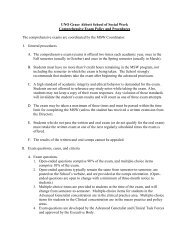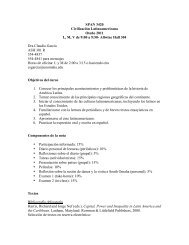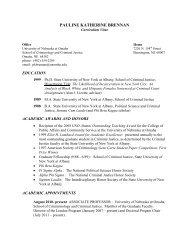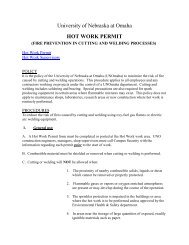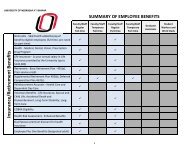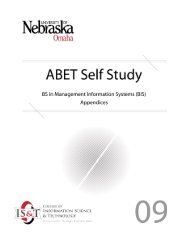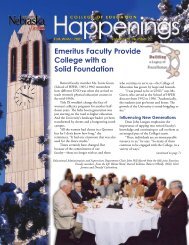Confined Space Entry Program - University of Nebraska Omaha
Confined Space Entry Program - University of Nebraska Omaha
Confined Space Entry Program - University of Nebraska Omaha
Create successful ePaper yourself
Turn your PDF publications into a flip-book with our unique Google optimized e-Paper software.
CONFINED SPACE ENTRY PROGRAM<br />
<strong>University</strong> <strong>of</strong> <strong>Nebraska</strong> at <strong>Omaha</strong><br />
Campus Safety <strong>Program</strong><br />
Purpose<br />
1.01 The purpose <strong>of</strong> this written program is to ensure safe entry methods are utilized<br />
prior to and during all work activities in confined spaces. This program is designed to<br />
prevent personal injuries and illnesses that may be prevalent in confined spaces and for<br />
compliance with OSHA Standard 29 CFR 1910.146.<br />
1.02 This program covers all employees and outside contractors. The elements contained in<br />
this program must be followed in all situations where entry into a permit or non-permit required<br />
confined space is necessary.<br />
Workplace Analysis and Hazard Evaluation <strong>of</strong> Permit <strong>Space</strong>s<br />
2.01 The <strong>Confined</strong> <strong>Space</strong> <strong>Entry</strong> <strong>Program</strong> requires the <strong>University</strong> Environmental Health and<br />
Safety Department (EHS) to perform a workplace analysis to determine if any spaces fit the<br />
criteria for a permit required confined space. Based on a walk through analysis <strong>of</strong> the workplace,<br />
both permit and non-permit confined spaces have been identified and their hazards evaluated.<br />
(See Appendix A.)<br />
Reclassification <strong>of</strong> Non-Permit <strong>Confined</strong> <strong>Space</strong>s<br />
3.01 It is the responsibility <strong>of</strong> the Maintenance Operations Services Department (MOS) to<br />
notify the Manager <strong>of</strong> Environmental Health and Safety (EHS) when there are changes in the<br />
use, or configuration, <strong>of</strong> the previously identified non-permit confined spaces that might increase<br />
the hazards to entrants, or when new equipment or construction takes place that creates new<br />
confined spaces. The EHS Manager shall re-evaluate the existing space or evaluate the new<br />
space and, if necessary, classify it as a permit required confined space according to the<br />
requirement 1910.146(c)(6).<br />
Measures to Prevent Unauthorized <strong>Entry</strong><br />
4.01 The <strong>University</strong> will post danger signs warning <strong>of</strong> the existence, location, and danger<br />
posed by the permit spaces identified above to prevent unauthorized entry into those spaces. The<br />
signs will be posted at the entrances to the spaces and read:<br />
DANGER<br />
Permit Required <strong>Confined</strong> <strong>Space</strong><br />
DO NOT ENTER
Safe Non-Permit <strong>Space</strong> <strong>Entry</strong> Operations<br />
5.01 All entries into non-permit confined spaces will be performed according to the procedures<br />
found on the checklist in Appendix C.<br />
Safe Permit <strong>Space</strong> <strong>Entry</strong> Operations - Means, Procedures, and Practices<br />
6.01 Acceptable entry conditions are specified as those in which:<br />
a. All hazards in a permit-required confined space that can be eliminated have been<br />
eliminated via engineering controls, (ventilation, or some other means);<br />
b. Authorized entrants are protected by use <strong>of</strong> PPE against any remaining or potential<br />
hazards; and<br />
c. All procedures <strong>of</strong> this program are being followed.<br />
6.02 The permit space shall be appropriately isolated from other work<br />
activity by means <strong>of</strong> signs and barriers as necessary. These may include<br />
barrier tape, barricades, traffic cones, etc.<br />
6.03 The permit space shall be purged, made inert, flushed, or<br />
ventilated with appropriate equipment as necessary to eliminate or control<br />
atmospheric hazards.<br />
6.04 Pedestrian, vehicle, or other barriers shall be provided as<br />
necessary to protect entrants from external hazards.<br />
6.05 Conditions in the permit space are acceptable for entry throughout the duration <strong>of</strong> an<br />
authorized entry as long as all monitoring, entry procedures, and attendant watch are performed<br />
as specified in the program.<br />
Equipment Provision<br />
7.01 The <strong>University</strong> will provide at no cost to the employee all appropriate, adequate, and<br />
necessary personal protective equipment (PPE), testing and monitoring equipment, ventilation<br />
equipment, communications equipment, lighting equipment, barriers and shields, ladders or other<br />
entrance/exit equipment, rescue and emergency equipment and any other equipment necessary<br />
for safe entry into and rescue from a permit-required confined space. The MOS supervisor will<br />
be responsible for ensuring use <strong>of</strong> the appropriate equipment by all entrants to the confined<br />
space. The air monitoring equipment will be calibrated once a month or prior to use by EHS.<br />
MOS supervisors will perform the field calibration or self check before each use. The results <strong>of</strong><br />
the calibrations will be recorded on the calibration log for the instrument.<br />
Permit <strong>Space</strong> Condition Evaluation<br />
8.01 Conditions in the permit space shall be tested to determine if acceptable entry<br />
conditions exist before entry is authorized to begin. If isolation <strong>of</strong> the space is infeasible because<br />
the space is large or is part <strong>of</strong> a continuous system (such as a sewer), pre-entry testing shall be<br />
performed to the extent feasible before entry is authorized and, if entry is authorized, entry<br />
conditions shall be continuously monitored in the areas where authorized entrants are working;
8.02 The permit space shall be tested or monitored as necessary to determine if acceptable<br />
entry conditions are being maintained during the course <strong>of</strong> entry operations; and when testing for<br />
atmospheric hazards, the supervisor will test first for oxygen, then for combustible gases and<br />
vapors, and then for toxic gases and vapors, or all simultaneously if the instrument will do so.<br />
Permit <strong>Space</strong> Attendant Procedures<br />
9.01 The <strong>University</strong> will provide at least one attendant outside the permit space into which<br />
entry is authorized for the duration <strong>of</strong> entry operations.<br />
Active Role Designations, Duties, and Training<br />
10.01 The <strong>University</strong> provides training so that all designated employees acquire the<br />
understanding, knowledge, and skills necessary for the safe performance <strong>of</strong> the duties assigned to<br />
them in permit-required confined space entry procedures. This training is provided annually and<br />
at the following times:<br />
Before assignment to duties.<br />
When changes in permit-required space hazards occur on which the employee<br />
has not been trained.<br />
Before changing the employees duty assignment.<br />
When the supervisor has reason to believe that the employee has deviated<br />
from a trained-upon procedure or that their knowledge is inadequate.<br />
10.02 The following categories <strong>of</strong> employees are designated employees, whose duties are listed<br />
below:<br />
Authorized entrants<br />
Attendants<br />
<strong>Entry</strong> Supervisors<br />
Authorized Entrants<br />
11.01 Authorized entrants <strong>of</strong> a permit-required confined space are trained to the extent<br />
that they know: the hazards they may face, are able to recognize signs or symptoms <strong>of</strong> exposure,<br />
and understand the consequences <strong>of</strong> exposure to hazards. Entrants know how to use any needed<br />
equipment, communicate with attendants as necessary, alert attendants to the warning signs or<br />
the existence <strong>of</strong> a hazardous condition, and exit as quickly as possible whenever ordered or<br />
alerted (by alarm, warning sign, or prohibited condition) to do so.<br />
Attendants<br />
12.01 Attendants to a confined space know the hazards <strong>of</strong> confined spaces, are aware <strong>of</strong><br />
behavioral effects <strong>of</strong> potential exposures, maintain continuous count and identification <strong>of</strong><br />
authorized entrants, remain outside the space until relieved, and communicate with entrants as<br />
necessary to monitor entrant status. Attendants also monitor activities inside and outside the<br />
permit space, order evacuation if required, summon emergency personnel if necessary, prevent<br />
unauthorized entry into the confined space, and perform non-entry rescues if required. They do<br />
not perform other duties that interfere with their primary duty to monitor and protect the safety <strong>of</strong><br />
authorized entrants at the time <strong>of</strong> the permit-required confined space entry.
Supervisors<br />
13.01 MOS supervisors with responsibility for issuing confined space permits know the hazards<br />
<strong>of</strong> confined spaces, conduct air monitoring and verify that all procedures and equipment are in<br />
place before endorsing a permit, terminate entry if necessary, cancel permits, and verify that the<br />
means for summoning emergency personnel are operable. Supervisors are to remove<br />
unauthorized individuals who enter the confined space. They also determine, at least when shifts<br />
and entry supervisors change, that acceptable conditions, as specified in the permit, continue.<br />
Rescue and Emergency Services Procedures<br />
14.01 Rescue and emergency services shall be contacted by phone or two-way radio by calling<br />
4-2911. <strong>Omaha</strong> Fire Department personnel will be called by Campus Security to respond in an<br />
emergency. At no time can non-emergency personnel enter a confined space for rescue<br />
purposes.<br />
14.02 The EHS Manager will inform the <strong>Omaha</strong> Fire Department <strong>of</strong> the hazards they encounter<br />
when called upon for rescue services.<br />
14.03 To facilitate non-entry rescue, retrieval systems or methods will be used whenever an<br />
authorized entrant enters a permit space, unless this would increase risk or would not assist the<br />
rescue. Retrieval systems will meet the following:<br />
a. Each authorized entrant will use a chest or full body harness with a retrieval line.<br />
b. The other end <strong>of</strong> the retrieval line will be attached to a mechanical device or fixed point<br />
outside the permit space so that rescue can begin as soon as it becomes necessary.<br />
<strong>Entry</strong> Permit System<br />
14.04 If an injured entrant is exposed to a substance for which an MSDS<br />
sheet or other similar written information is required, that sheet or written<br />
information will be made available to the medical facility treating the<br />
exposed entrant.<br />
15.01 Before entry is authorized, the MOS supervisor will document the<br />
completion <strong>of</strong> required pre-entry measures by preparing an entry permit.<br />
(See Appendix B.)<br />
15.02 Before entry begins, the entry supervisor identified on the permit<br />
will sign the entry permit to authorize entry.<br />
15.03 The completed permit is made available at the time <strong>of</strong> entry to all<br />
authorized entrants, by posting it at the entry portal or by any other equally<br />
effective means, so that the entrants can confirm that pre-entry<br />
preparations have been completed.<br />
15.04 The permit expires when the work is completed.
15.05 The entry supervisor shall terminate entry and cancel the entry<br />
permit when:<br />
a. The entry operations covered by the entry permit have been<br />
completed; or<br />
b. A condition that is not allowed under the entry permit arises in or<br />
near the permit space.<br />
15.06 The <strong>University</strong> shall retain each canceled entry permit for at least 1 year to facilitate the<br />
required annual review <strong>of</strong> the permit-required confined space program. Any problems<br />
encountered during an entry operation shall be noted on the pertinent permit so that appropriate<br />
revisions to the permit space program can be made<br />
15.07 See Appendix B for the entry permit form used by the <strong>University</strong>.<br />
Multiple Employer <strong>Entry</strong> Procedures<br />
16.01 Procedures for Outside Contractors:<br />
When the <strong>University</strong> arranges to have employees <strong>of</strong> another employer (contractor) perform work<br />
that involves permit space entry, the <strong>University</strong> will:<br />
16.02 Inform the contractor that the workplace contains permit spaces and that permit space<br />
entry is allowed only through compliance with a permit space program.<br />
16.03 Apprise the contractor <strong>of</strong> the elements, including the hazards identified and the<br />
<strong>University</strong>s experience with the space, that make the space in question a permit space.<br />
16.04 Apprise the contractor <strong>of</strong> any precautions or procedures that the <strong>University</strong> has<br />
implemented for the protection <strong>of</strong> employees in or near permit spaces where contractor personnel<br />
will be working.<br />
16.05 Coordinate entry operations with the contractor, when both<br />
<strong>University</strong> and contractor personnel will be working in or near permit<br />
spaces.<br />
16.06 Debrief the contractor at the conclusion <strong>of</strong> the entry operations<br />
regarding effectiveness <strong>of</strong> the permit space program.<br />
Post-operations Procedures<br />
17.01 The MOS supervisor will close <strong>of</strong>f a permit space and cancel the permit after entry<br />
operations have been completed.<br />
Review Procedures<br />
18.01 The EHS Manager will review entry operations when there is<br />
reason to believe that the measures taken under the permit space program<br />
may not protect employees and the program will be revised to correct<br />
deficiencies found to exist before subsequent entries are authorized.
18.02 Examples <strong>of</strong> circumstances requiring review <strong>of</strong> the permit space<br />
program are: any unauthorized entry <strong>of</strong> a permit space, the detection <strong>of</strong> a<br />
permit space hazard not covered by the permit, the detection <strong>of</strong> a condition<br />
prohibited by the permit, the occurrence <strong>of</strong> an injury or near-miss during<br />
entry, a change in the use or configuration <strong>of</strong> a permit space, and<br />
employee complaints about the effectiveness <strong>of</strong> the program.<br />
18.03 The EHS Manager will review the permit space program using the<br />
retained canceled permits and revise the program as necessary, to ensure<br />
that employees participating in the entry operations are protected from<br />
permit space hazards. The <strong>University</strong> will perform a single annual review<br />
covering all entries performed during a 12 month period. If no entry is<br />
performed during a 12 month period, no review will be performed.<br />
5/28/99<br />
Appendix A - Examples <strong>of</strong> <strong>Confined</strong> <strong>Space</strong>s and their Classification at UNO (PDF)<br />
Location<br />
Campus<br />
Wide<br />
Permit<br />
Required<br />
No<br />
Description Potential Hazard Contaminants/gases<br />
Sewer<br />
manholes<br />
Oxygen deficient<br />
atmosphere; potential air<br />
contamination<br />
O 2 , H 2 S, CH 4 , NH 3<br />
Campus<br />
Wide<br />
No<br />
Water<br />
manholes<br />
Oxygen deficient<br />
atmosphere<br />
O 2<br />
Campus<br />
Wide<br />
No<br />
Steam line pits<br />
Heat hazard; Oxygen<br />
deficient atmosphere<br />
O 2<br />
Campus<br />
Wide<br />
No<br />
Sanitary sewer<br />
Oxygen deficient<br />
atomosphere; potential air<br />
contamination<br />
O 2 , H 2 S, CO<br />
Campus<br />
Wide<br />
No<br />
Air handlers<br />
Electric, Mechanical, Fans,<br />
Belts<br />
Campus<br />
Wide<br />
No<br />
Hot water<br />
tanks<br />
Oxygen deficient<br />
atmosphere; limited egress<br />
and entry<br />
O 2<br />
Campus<br />
Wide<br />
No<br />
Low-voltage<br />
electrical<br />
access pits<br />
Oxygen deficient<br />
atmosphere; limited egress<br />
and entry<br />
O 2 , CO<br />
Campus<br />
Wide<br />
No<br />
High-voltage<br />
electrical<br />
access pits<br />
Potential air contamination<br />
(CO); Oxygen deficient<br />
atmosphere<br />
O 2 , CO<br />
Central<br />
Utilities<br />
Yes Boilers Limited egress and entry O 2 , soot<br />
Central No H2O Oxygen deficient O 2
Utilities<br />
Condenser<br />
sump pit<br />
atmosphere; limited egress<br />
and entry<br />
Central<br />
Utilities<br />
No<br />
Cooling tower<br />
pit<br />
Oxygen deficient<br />
atmosphere; potential air<br />
contamination<br />
O 2 , H 2 S, CO,<br />
biologicals<br />
Central<br />
Utilities<br />
No<br />
Hot<br />
condensate<br />
return pit<br />
Oxygen deficient<br />
atmosphere; limited egress<br />
and entry<br />
O 2<br />
HPER<br />
No<br />
Pool pump<br />
room pit<br />
Oxygen deficient<br />
atmosphere; possible air<br />
contamination<br />
O 2 , Cl 2<br />
HPER<br />
No<br />
Pool pump<br />
room pit<br />
catwalk<br />
Oxygen deficient<br />
atmosphere; possible air<br />
contamination<br />
O 2 , Cl 2<br />
HPER<br />
No<br />
Tunnel around<br />
pool<br />
Oxygen deficient<br />
atmosphere<br />
O 2<br />
Eppley<br />
Building<br />
No<br />
Basement pipe<br />
access<br />
Oxygen deficient<br />
atmosphere<br />
O 2<br />
CBA<br />
No<br />
Pods-crawl<br />
space<br />
Limited egress and entry;<br />
mechanical<br />
Library<br />
No<br />
Ventilation<br />
tunnel<br />
Limited egress and entry<br />
Appendix B - <strong>Confined</strong> <strong>Space</strong> <strong>Entry</strong> Permit (PDF)<br />
Appendix C - Non-Permit <strong>Confined</strong> <strong>Space</strong> Checklist (PDF)<br />
Date:<br />
Department:<br />
Expiration Date:<br />
_______________<br />
Job Description: ________________________________________________________________<br />
Location: ____________________________________________________________________<br />
Precautions Taken: (Check one or more.)
1.<br />
manholes<br />
Ventilation/blower used before entering all pits, sewers,<br />
2. Ventilation/blower used continuously while personnel in<br />
space. ______<br />
3. Continuous oxygen monitoring performed while personnel in space. ______<br />
4. Emergency procedures reviewed.<br />
______<br />
Atmospheric Testing:<br />
Monitoring<br />
Initial<br />
Initial<br />
Continuous<br />
Required Reading Alarm Alarm<br />
Yes No Yes No Yes No<br />
Oxygen ____ ____ _______ ____ ____ ____ ____<br />
Combustible ____ ____ _______ ____ ____ ____ ____<br />
Toxic ____ ____ _______ ____ ____ ____ ____<br />
*If alarm levels are reached, notify EHS, DO NOT ENTER space.<br />
Description <strong>of</strong> the hazards known or reasonably expected to be present in the confined space:<br />
Name(s) <strong>of</strong> person(s) assiged to enter:<br />
Qualified Tester: ______________________________________<br />
Hazards, Testing, Ventilation, and Emergency Procedures have been reviewed.<br />
Supervisor Signature: _________________________________________


